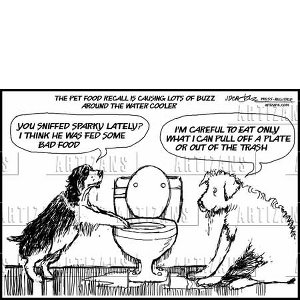
Controversial Pet Food Recall
In 2007, many cats and dogs were getting sick or dying from contamination in their food, which was eventually traced back to the use of melamine in combination with cyanuric acid. In the aftermath of this tragedy, many people wondered why the Food and Drug Administration (FDA), which regulates pet food, would allow the use of melamine in cat or dog food. I will explore why melamine was allowed to be used in pet food and what can be done to prevent another catastrophe like this one from happening again.
In 2007, the source of the pet food contamination was determined to be melamine—a fatal chemical that was in the wheat gluten and rice protein used in pet food. Melamine is known to be used in industrial and household products, but usually not in food. According to Skinner, Thomas and Osterloh, “melamine is high in nitrogen and allegedly was added to animal feeds to increase the apparent protein content in assays that measure nitrogen as a surrogate for protein content” ( 51). The problem is that the melamine can cause kidney damage if it is combined with cyanuric acid, even though melamine by itself has low toxicity. The use of melamine in the pet food, along with the additive cyanuric acid, caused urinary crystals to form and led to the kidney damage in the pets.
Unfortunately, melamine was allowed to be used in the pet food because its use in that food was not regulated. The production of melamine involves cheap labor and costs the United States China before it was imported to the United States United States
Eventually, melamine was exposed as dangerous when thousands of pet owners over all the United States complained of their beloved pets falling ill. Specifically, dogs and cats were diagnosed with acute kidney failure from the contaminated pet food that was recalled. Pets that ate the contaminated food showed signs of vomiting, diarrhea, loss of appetite and feeling really sluggish. In the meantime, Menu Foods Inc. called up the FDA to allow them to further investigate how these cats and dogs were getting sick. Eventually, melamine showed up in the wheat gluten after all the tests were conducted. According to the DVM Newsmagazine, “The FDA announced that, in addition to melamine, cyanuric acid (also originating in China and containing a relatively high level of non-protein nitrogen) was added to pet foods” (“Unmasking”). As Nestle pointed out, a group of three scientists—from the University of Guelph , Cornell University , and Michigan State University
To prevent this tragedy from happening again, the FDA should inform consumers by being more concise about what the pet food label standard is and to be clearer about what is inside the ingredients. The FDA should be more careful about who and where they get the chemicals from. In addition, pet owners themselves should be more diligent in doing research before they go out and buy food for their beloved animals. As noted in the DVM Newsmagazine, “The new amendments also give the FDA two years to update pet-food labeling guidelines that include accurate nutritional and ingredient information, and to update food-processing standards” (“FDA to set”). The regulations are done by checking imported products that come from China or other countries to make sure no illegal substance is added to the pet food and to make sure all labeling is done correctly—they don’t want to make the same mistake that occurred in 2007. According to the FDA, “they mobilized more than 400 employees to collect pet food sample, monitor the effectiveness of the recall, and prepare consumer complaint report” and they “conducted numerous inspections of manufacturing facilities and warehouses to trace the entire contaminated product”.
In my final analysis, I realize that pet food is not really as regulated as human food is. The outbreak of illnesses and deaths of cats and dogs—caused by the addition of the chemicals melamine and cyanuric acid to pet food—was an eye opener, especially to the government. As a result, the FDA is now taking charge in doing a better job regulating pet food. If the government had done so before, perhaps this tragedy could have been prevented.
Works Cited
Barboza, David, Alexei Barrionuevo.”Filler in Animal Feed Is Open Secret in China.” New York Times. New York Times, 30 April 2007. Web. 14 May 2011.
“FDA to set pet-food warning system, labeling guidelines.”DVM: The Newsmagazine of Veterinary Medicine 39.1(2008):41. Academic Search Complete. Web. 14 May 2011.
FDA U.S. Food and Drug Administration. Pet Food Recall: FDA’s Ongoing Investigation. 16 April 2007. Web. 18 May 2011. <http://www.fda.gov/ForConsumers/ConsumerUpdates/ucm048192.htm>
Nestle, Marion.”Pet food politics: The Chihuahua in the Coal Mine”. Berkeley: University of California Press, 2008. Print.
Skinner, Carl G., Jerry D. Thomas, and John D. Osterloh. “Melamine Toxicity.” Journal of Medical Toxicology 6.1 (2010): 50-55. Academic Search Complete. Web. 14 May 2011.
“Unmasking the toxic culprits(S) in pet-food recalls.”DVM: The Newsmagazine of Veterinary Medicine 39.9 (2008): 32-35. Academic Search Complete. Web. 14 May 2011.

